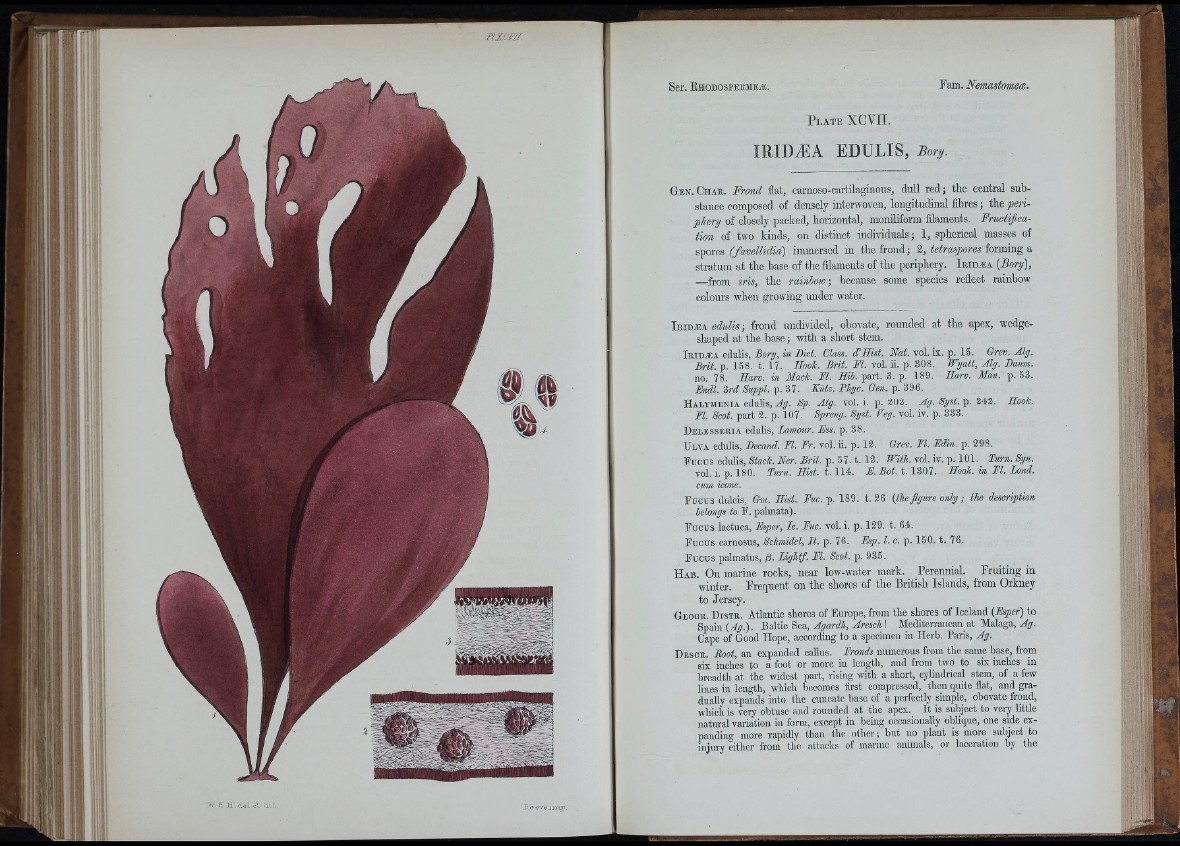
f i x e m .
Ser. R h o d o s p e b m eæ . Pam. Nemastomeoe.
w. H .H . d e ls ! lith JleeTe.jnLp.
P l a t e XCVII.
IRIDÆA EDULIS, B o r y .
Gen. Chae. Frond flat, carnoso-cartilaginous, dull red ; the central substance
composed of densely interwoven, longitudinal fibres ; th ejom -
phery of closely packed, horizontal, moniliform filaments. Fructification
of two kinds, on distinct individuals; 1, spherical masses of
spores (favellidia) immersed in the frond; 2, tetraspores forming a
stratum at the base of the fllaments of the periphery. I eidæa {Bory),
—from iris, the rainbow; because some species reflect rainbow
colours when growing under water.
I eidæa edulis; frond undivided, obovate, rounded at the apex, wedge-
shaped at the base ; with a short stem.
I ridæa edulis, Bory, in Bict. Class. d'Hist. Nat. vol. ix. p. 15. Grev. Alg.
Brit. p. 158. 1 .17. Hook. Brit. FI. vol. ii. p. 308. Wyatt, Alg. Banm.
no. 78. Harv. in Mack. FI. Hih. part. 3. p. 189. Harv. Man. p. 53.
Fkdl. 3rd Suppl. p. 37. Kiitz. Phyc. Gen. p. 396.
H a it m e n ia edulis, Ag. Sp. Alg. vol. i. p. 302. Ag. Syst. p. 343. Hook.
FI. Scot. part 3. p. 107. Spreng. Syst. Veg. vol. iv, p. 333.
D e l e s s e r ia e d a lis , Lamour. Ess. p . 3 8 .
Ulva edulis, Becand. El. Er. vol. ii. p. IS. Grev. El. Edin. p. 398.
Pu cu s edulis, Stack. Ner. Brit. p. 5 7 .1 .13. With. vol. iv. p. 101. Turn. Syn.
vol. i. p. 180. Turn. Hist. 1 .114. E .B o t. 1 .1307. Hook, in El. Land,
cum icone.
Puous dulcis, Gm. Hist. Eue. p. 189. t. 26 {the figure only ; the description
belongs to P. palmata).
Puous lactuca, Esper, Ic. Fuc. vol. i. p. 139. t. 64.
P u cu s carnosus, Schmidel, It. p. 76. Esp. I. c. p. 150. t. 76.
Puo u s pahnatus, lAghtJ. FI. Scot. p. 935.
H ab. On marine rocks, near low-water mark. Perennial. Pruiting in
winter. Frequent on the shores of the British Islands, from Orkney
to Jersey.
G e o g r . D i s t e . Atlantic shores of Europe, from the shores of Iceland {Esper) to
Spain (aÎî/.). B a ltic Sea, ^m c /i ! Mediterranean at Malaga,
Cape of Good Hope, according to a specimen in Herb. Paris, Ag.
D e s c e . Boot, an expanded callus. Eronds numerous from the same base, fi-om
six inches to a foot or more in length, and from two to six inches m
breadth at the widest part, rising with a short, cylindricid stem, of a few
lines in length, which becomes first compressed, then quite fiat, and gradually
expands into the cuneate base of a perfectly simple, obovate frond,
which is very obtuse and rounded at the apex. I t is subject to very little
natural variation in form, except in being occasionally oblique, one side expanding
more rapidly than the other ; but no plaut is more subject to
injiuy either from the attacks of marine animals, or laceration by the
i
'/;l
I J
IP T
SMi f:i:
« i|| «
J i